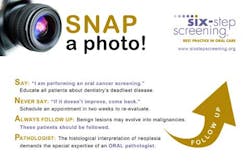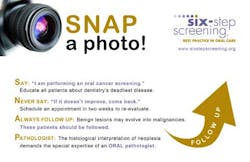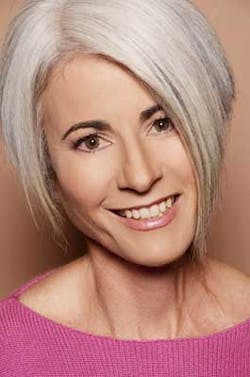A story NOT silenced by oral cancer
Back in 1995, my dentist whom I saw regularly, always pulled my tongue out with gauze, felt the grooves of my mouth and even palpated my neck. I didn’t know what was being done to me, only that it was part of an oral health exam. I never heard the words "oral cancer." I never knew cancer could exist in the mouth. It was outside of my radar, beyond my scope of what could be possible.
I never sensed alarm as the sore on my tongue was monitored. I was bounced between two dentists and two oral surgeons for nine months, without a mention of oral cancer being a possibility. Why did my dentists and oral surgeons NOT recognize what was staring at them on my lateral tongue: a classic Squamous Cell Carcinoma.
I want to know the truth. Was it my young age? Was it because I never smoked? Was it because my initial biopsy was misread by a general pathologist as hyperkeratosis and not dysplasia? Was it because my dentists and oral surgeons did not have up-to-date education on oral cancer? Was it because I went to a different oral surgeon than the one my dentist referred me to and hence they did not communicate? Was it because I was viewed as a "complainer" when I asked to see another surgeon in the practice? Where did my care go wrong? Even after 14 years, I still want to know the truth.
If my cancer was diagnosed early, it would have been a week or two from surgery to recovery. Instead, six months of my life passed in surgery, treatment and recovery. It was followed by repercussions of trauma to my children. It continues with a lifetime of dental complications, numerous doctor appointments, health scares, occasional ringing in my ears, sensitivity in my eyes to sunlight and quality of life compromises such as xerostomia, feeling and tasting only on one side of my tongue, and limitations in neck movement. But, I’m one of the lucky ones who survived this potentially devastating disease, swallowing normally, speaking with articulation, and without facial disfigurement.
MOTIVATING CHANGE
One day, while in NYC for a follow-up visit with my surgeon, a bus with a big ad on its side read, "There’s a painless way to know if this is anything serious." The photo was of a young woman, who looked a bit like me, with her tongue off to the side and a white spot exactly where mine was. The ADA logo was prominent.
As soon as I got home, I called the ADA’s 800 number, and left this message, “I saw the campaign you are promoting in New York City, you need to know about me and I want to help you.” After making two educational videos with the ADA about oral cancer, I was asked to speak at the 2003 annual conference. This experience made me realize the impact I can have to save lives by sharing my personal story.
The audience doesn’t just hear my story; they "experience" it, as they travel the journey with me from a delayed diagnosis of late-stage oral cancer, through the surgery and treatment. When dental professionals hear my presentation they say, “I never want what happened to Eva to happen to any of my patients.”
Because of the intimate nature of my story, and the fact that someone such as themselves could have prevented it, motivates them to change how they practice. In contrast to the clinical perspective at educational conferences, I humanize oral cancer, inspiring the audience both professionally and personally.
After getting a second chance at life, I felt it was my obligation to do all I could to prevent the same from happening to someone else. I developed Six-Step Screening to educate the general public and dental professionals about the existence of this debilitating and deadly disease, and its early signs.
I never once heard the words "oral cancer" until the day I was diagnosed. My dentists and oral surgeons had no idea that the sore staring at them on my lateral tongue was squamous cell carcinoma. In addition to my mission to educate, Six-Step Screening is my tribute to those who came before me and my obligation to those who will follow.
By publicly sharing my personal journey to help others, I'm gaining back all the years and more of life that oral cancer took from me. The website I developed, www.sixstepscreening.org, explains the six steps to a thorough oral cancer screening in an easy-to-follow format with memorable titles.
THE SIX-STEP SCREENING
Tongue ‘n Gauze
Pull out the tongue with gauze; visually examine it for any swelling, ulceration or variation in size, color or texture.
Lip & Cheek Roll
Feel for lumps and bumps & look for red or white areas that should not be there.
Double-Digit Probe
Floor of the mouth is examined from the top & bottom simultaneously for lumps.
Palate Tickle
Check the hard and soft palate visually and palpate with your finger.
Neck Caress
The neck should be palpated, checking for enlarged lymph nodes.
Tonsil Ahhhhhh
The back of throat & tonsils should be examined for asymmetry, redness or ulceration.
The Six-Step Screening SNAP Mnemonic:
SNAP a PHOTO: Keep a digital camera on-hand to photograph irregularities so you have visual documentation.
S- Say, “I am performing an oral cancer screening.” Educate all patients about dentistry’s deadliest disease. Dentists say "Don’t sugar coat your teeth." I say, "Don’t sugar coat oral cancer." Use the words. Educate your patients. Take responsibility.
N- Never say, “If it doesn’t improve, come back.” Schedule an appointment in two weeks to re-evaluate.
A- Always follow up. Benign lesions may evolve into malignancies. These patients should be followed.
P- The histological interpretation of neoplasia demands the special expertise of an ORAL pathologist.
For the general public, unique pages on sixstepscreening.org include the Email Reminder, The Faces and Stories of Oral Cancer Survivors, Newly Diagnosed, and Is it Oral Cancer? For dental professionals, unique pages include Photos of Early Stage Oral Cancer, Videos of Oral Cancer Screenings, a Knowledge Assessment Quiz, and Oral Cancer Malpractice Tips. Failure to diagnose oral cancer is the No. 2 cause of dental malpractice claims.
Editorial Director’s NoteMeet Mr. C, a cancer cell, face-to-face. Through vibrant photos and endearing illustrations, readers understand the life of cancer from the perspective of the cell itself. Charming and personable, Mr. C shares the rules of his game. Different doctors are introduced who look for cancer and try to beat Mr. C at his game. Don’t "hide" a cancer diagnosis from children – "seek" out the Talk4Hope Book Series! IT: Makes cancer less scary for children; Includes tools for coping and communication; and Provides a sense of empowerment.(1)
Meet Mr. C, a cancer cell, up close and personal, as he visits countries around the globe. He introduces readers to children who have a family member with cancer. Each child shares his or her name, it’s meaning, and how they’ve been coping since Mr. C came to visit. Readers are empowered with ways to help themselves and others.(2)
CLOSING COMMENTS
Whose responsibility is it to educate patients about oral cancer? Oral cancer needs to be on the radar, just like breast cancer and melanoma. Screening is just as important as cleaning. Many dental professionals say they do an oral cancer screening but it varies from a quick look to the "Real McCoy."
The challenge is to motivate every dentist and dental hygienist to perform a thorough screening on every patient at every dental checkup. No state in this country mandates regular CE in early detection of oral cancer. (New York State is the first state to implement a one-time requirement that dentists earmark 2 hours of their CE to a course devoted to the prevention and detection of oral cancer.) Taking a course on oral cancer detection is about providing the best care for patients. If you could save one life in your entire career by catching oral cancer early, isn’t it worth it?
Eva Grayzel
Inspires. Motivates. Transforms...
through the power of story
Motivational Speaker, Master Storyteller, Author
W: 610.258.3763 M: 610.554.9375
www.evagrayzel.com
www.sixstepscreening.org™
www.talk4hope.com
References
1. http://www.evagrayzel.com/talk4hope/mr-c-plays-hide-seek.
2. http://www.evagrayzel.com/talk4hope/mr-c-the-globetrotter.
To read articles in RDH eVillage FOCUS written by Eva Grayzel, click here.
To read more about oral cancer and dental hygiene, click here.




